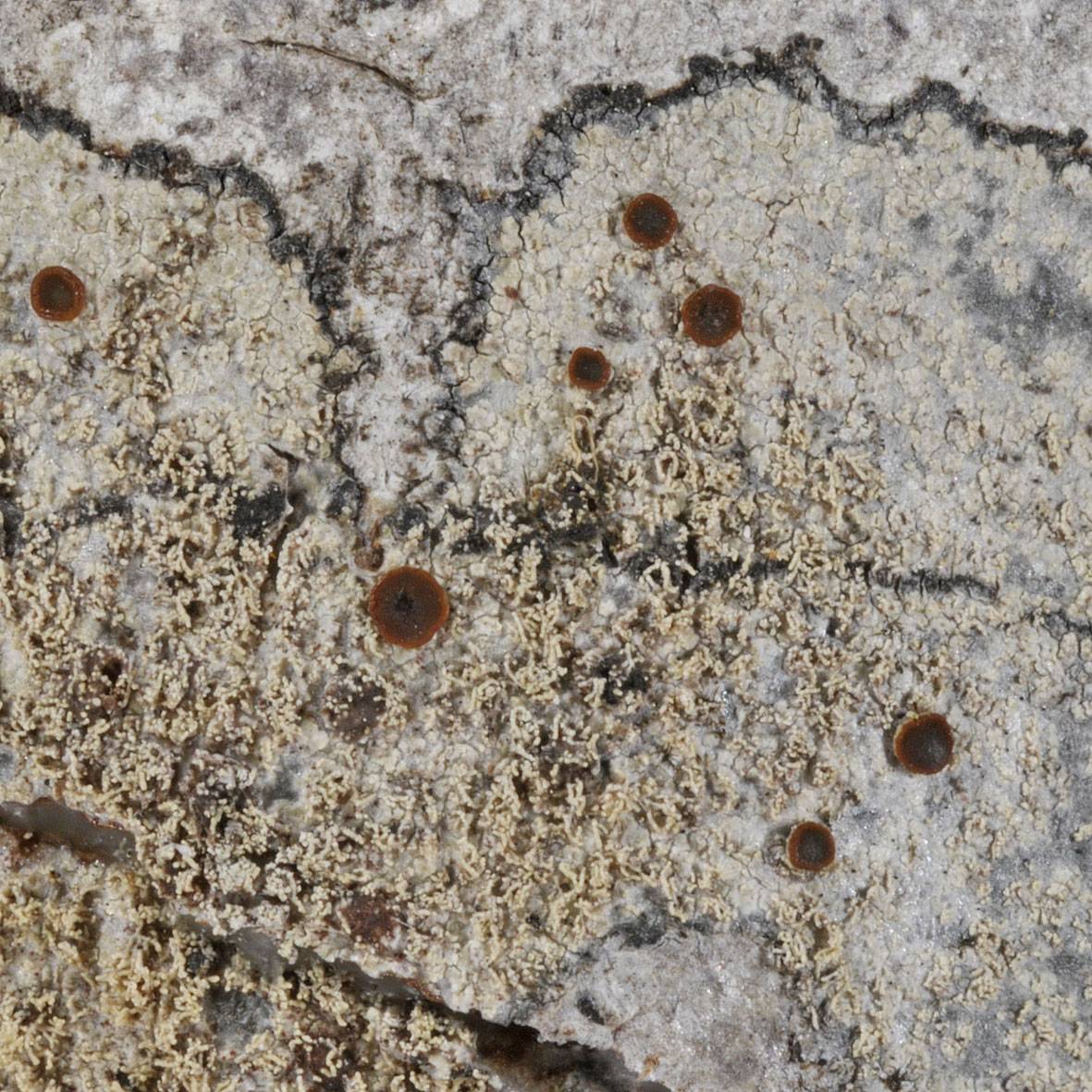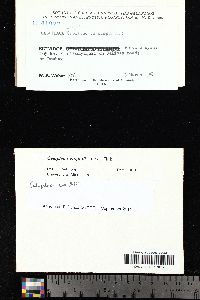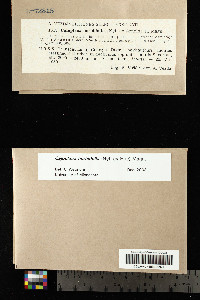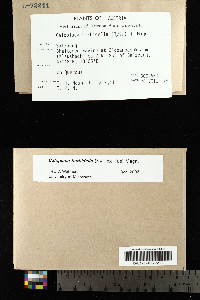
- Home
- Search
- Images
- Species Checklists
- US States: O-Z >
- US National Parks
- Central America
- South America
- US National Parks
- Southern Subpolar Region
|
|
|
|
Family: Teloschistaceae
[Caloplaca hensseniana Kalb, moreCaloplaca neotropica Wetmore, Caloplaca wrightii (Willey) Fink, Placodium ferrugineum var. wrightii Willey] |
MB#836937 Basionym: Placodium ferrugineum var. wrightii Tuck., A synopsis of the North American lichens 1: 178. 1882. MB#245802. Description. Thallus either as thin and poorly developed, isolated to irregularly associated verruculose areoles on a smooth blackish gray hypothallus, or irregularly thickened and at least in part rimose-areolate to distinctly verruculose areolate, typically ± discontinuous, with discrete, contiguous thallus areas interrupted by thin, poorly developed parts and a blackened hypothallus in between, which also delimits the effuse periphery as a compact, blackened, ± carbonaceous prothallus; surface pale creamy white to grayish, smooth to ± roughened, dull to ± shiny (in parts ± ‘waxy’), epruinose, sparsely to densely isidiate; isidia granular to cylindrical and sparsely to irregularly branched, rarely ± coralloid, pale creamy white, darker gray to bluish green at their tips, ~ 0.06–0.08 mm in diam., the whole thallus eventually appearing pale greenish gray as a result of the dense isidia (fertile specimens often with a thicker, better developed thallus and less densely isidiate; poorly developed, sterile specimens typically with few, pale clusters of isidia on a bluish black hypothallus). Apothecia, frequently absent or sparse to sometimes numerous, dispersed, up to 1.2 mm in diam., ‘zeorine’ to almost biatorine; thalline margin soon excluded by being pushed below, beige to whitish, sometimes granular to isidioid (in the herbarium often blackened with age); proper margin almost level with disc, persistent, ~100 μm thick, regularly circular to slightly flexuose; brownish to rust-red orange, epruinose, C-, K+ purple; disc flat, deep brownish to rust-red orange, epruinose, C-, K+ purple; epihymenium deep orange-brown, strongly colored by deep orange pigment granules, C– (± intensifying winered), K+ violet, pigmentation contiguous with upper part of the outer exciple; hymenium hyaline, not inspersed; proper exciple differentiated into an inner, hyaline part, lacking crystals, and an outer pigmented part, strongly colored by deep orange pigment granules, C– (± intensifying wine-red), K+ violet; thalline exciple initially developed along the outside, soon pushed below, densely filled with trebouxioid photobionts and small crystals that dissolve in K, the outside not distinctly pigmented, C-, K-; subhymenium grayish, hypothecium hyaline, both not inspersed; asci clavate, Teloschistes-type; ascospores 8/ascus, polaribilocular, spores narrowly ellipsoid to weakly citriform (moderately tapering), (10.0–)11.9–14.7(–16.0) × (6.1–)7.4–9.3(–10.3) μm, with a thick, (2.9–)3.6–5.3(–6.0) μm wide septum (n = 35). Pycnidia unknown. Chemistry. Thallus P-, K-, C+ orange, KC+ orange, UV+ deep to bright yellow orange, apothecia P-, K+purple, C–, KC± purplish (fading), UV+ deep to bright yellowish orange; the thallus only contains lichexanthone, apothecia additionally also chrysophanal and rhein. Wetmore (2007) reports parietin and emodin; neither of these compounds were found in the Galapagos specimens. Ecology and distribution. According to Wetmore (2007a), occurring from southwestern USA through Mexico into northern South America: New to Ecuador and the Galapagos, where the species is common throughout the dry and lower transition zone, typically in sunny, wind- and rain-exposed habitats, most frequently on Bursera graveolens, occasionally on Cordia lutea, Prosopis juliflora, and few other trees characteristic of dry, open woodland. Notes. Huneckia wrightii is a well-delimited species, easily recognized if fertile. Specimens lacking apothecia could be confused with Pertusaria xanthoisidiata, but that species has a much thicker, yellowish green thallus with a more contiguous smooth surface and much coarser, stout isidia (~0.1–0.16 mm in diam.), that frequently erode at their tip. The isidia in H. writhii do not erode apically, but break off entirely. Its thalli fluoresce UV+ deep to bright yellow orange due to lichexanthone, whereas those of P. xanthoisidiata are UV± dull orange (for comparison see also Bungartz et al. 2015). If sterile, specimens of Megalaria bengalensis could be mistaken for H. wrightii. Thalli of M. bengalensis are greenish, contain no xanthones and, therefore, do not fluoresce (UV–), their isidia are much finer (typically less than 0.07 mm in diam.). When fertile, the specimens with their black, distinctly lecideine apothecia can of course not be confused. Nash, T.H., Ryan, B.D., Gries, C., Bungartz, F., (eds.) 2007. Lichen Flora of the Greater Sonoran Desert Region. Vol 3. Life habit: lichenized Thallus: crustose, areolate, without elongated lobes; prothallus: absent surface: gray, verruculose, isidiate isidia: laminal, cylindrical, mostly unbranched cortex: adglutinate hyphae, thick Apothecia: adnate, 0.3-1 mm in diam., lecanorine disc: dark brown or black, flat or slightly concave, epruinose margin: disappearing; thalline margin present, concolorous with thallus; proper margin visible, concolorous with disc parathecium: consisting of radiating hyphae; exciple below hypothecium irregular hyphae epihymenium: golden or brown, K-, H-, 10%N-, cN-, C- hymenium: hyaline, 70-85 µm tall; tip cells not swollen, frequently branched; subhymenium hyaline asci: cylindrical, 8-spored ascospores: hyaline, 2 locules, ellipsoid, 14-15.5 x 7-8.5 µm, isthmus 4-5.5 µm, spore end wall thickened Pycnidia: not observed Spot tests: apothecial margin K-, H-, 10% N-, cN-, C-; thallus K-, H-, 10%N-, cN-, C- Secondary metabolites: parietin and emodin. Substrate and ecology: on bark World distribution: southwestern North America, northern South America, and Mexico Sonoran distribution: Baja California Sur. Notes: Caloplaca wrightii has a distinct whitish gray thallus and the apothecial discs are brown to black. The isidia usually are simple but they may occasionally branch. In C. lagunensis the isidia are more coralloid and the apothecial discs are orange. According to Tucker (this volume) Hasse material from southern California may also prove to be this species. |






























